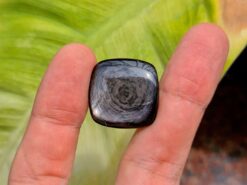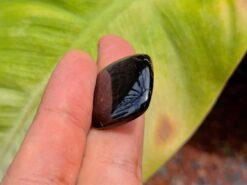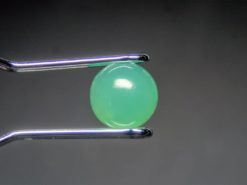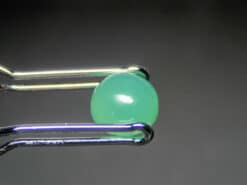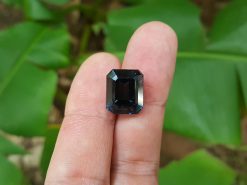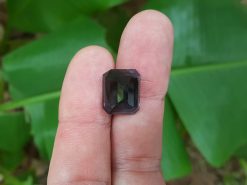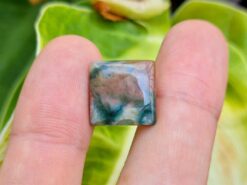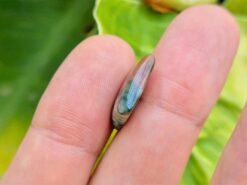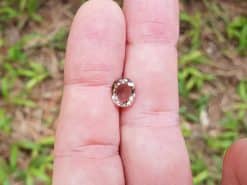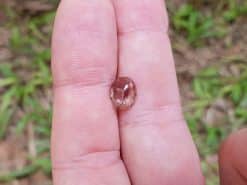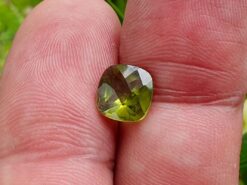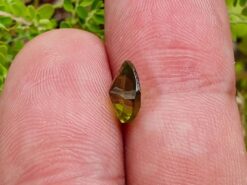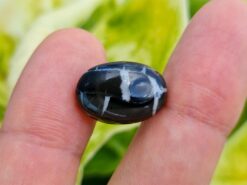Agate geode
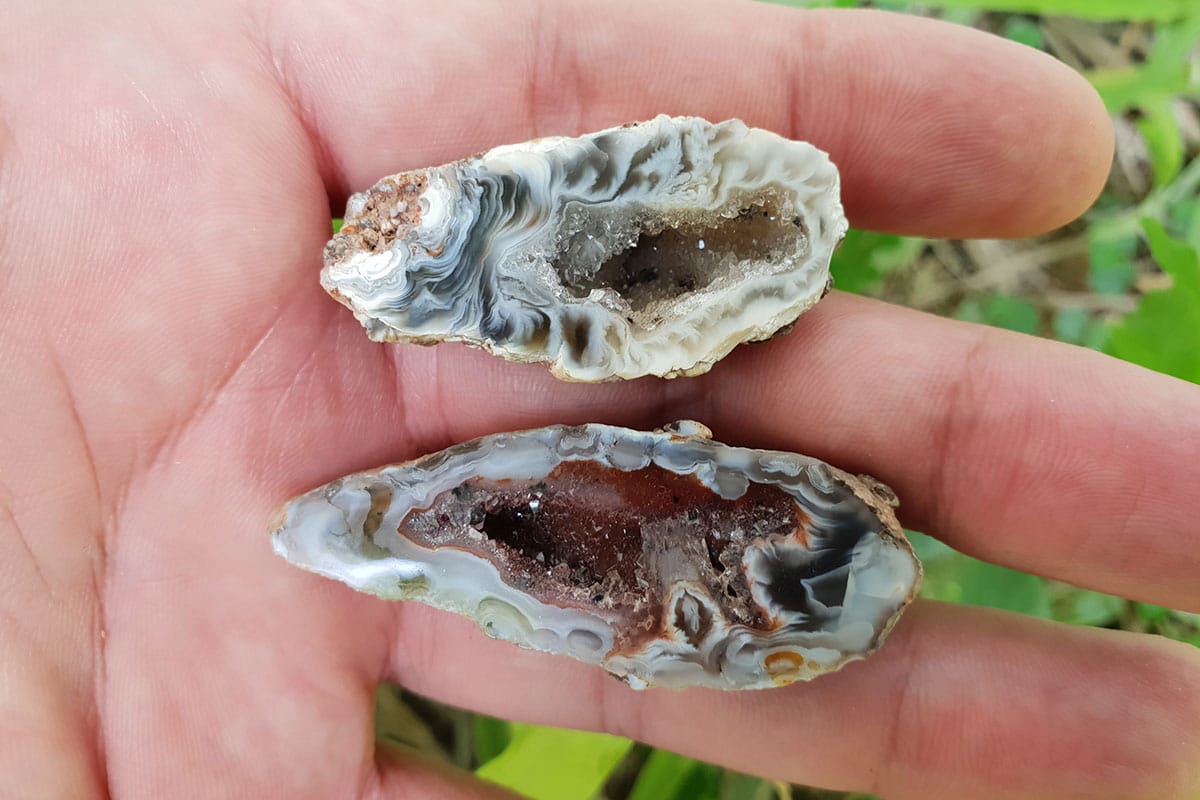
Agate is a rock consisting primarily of cryptocrystalline silica, chiefly chalcedony, alternating with crystalline quartz.
Buy natural gemstones in our gem shop
Agate geode crystal
It is visible by its fineness of grain and variety of color. Although we found agates in various kinds of host rock. We usually find it with volcanic rocks. And it can be common in certain metamorphic rocks.
Most agates occur as nodules in volcanic rocks or ancient lavas. In former cavities produced by volatiles in the original molten mass. It were then filled, also wholly or partially, by siliceous matter deposited. In regular layers upon the walls.
Agate can also fill veins or cracks, in volcanic or altered rock underlain by granitic intrusive masses. Such agates, when cut transversely, exhibit a succession of parallel lines. It is often of extreme tenuity. It gives a banded appearance to the section. Such stones are banded agate, also riband agate and striped agate.
In the formation of an ordinary agate, it is probable that waters containing silica in solution derived. Perhaps, from the decomposition of some of the silicates in the lava itself. It percolates through the rock and deposited a siliceous gel in the interior of the vesicles.
Variations in the character of the solution or also in the conditions of deposition. It may cause a corresponding variation in the successive layers. So that bands of chalcedony often alternate with layers of crystalline quartz.
Geode slices
agate geodes are geological secondary structures which occur in certain sedimentary and volcanic rocks. They are themselves of sedimentary origin and naturally made by chemical precipitation. Geodes are hollow, vaguely spheroid to oblate masses of mineral matter. It may include crystals.
It is form either by the filling of vesicles in volcanic to sub volcanic rocks by minerals deposited. From hydrothermal fluids or by the dissolution of igneous nodules or syngenetic concretions. And partial filling by the same or also other minerals. It is precipitated from diagenetic water, also groundwater or hydrothermal fluids.
agate geodes differ from vugs in form. Its form comes early, rounded. They structures within the surrounding rock. Geodes also differ from nodules. A nodule is a mass of mineral matter that has accreted around the nodule nucleus. Both structures had the minerals contained within, deposited from groundwater or also hydrothermal processes.
Agate geode meaning and healing metaphysical properties benefits
The following section is pseudo scientific and based on cultural beliefs.
It is also known as a good luck stone. As a stone of harmony, one of the things agate does is balance yin/yang energy. Agate increases energy. Emotionally, agate gives courage, emotional strength, self-confidence, and dispels fears. It can also lessen feelings of envy by grounding the emotions.
Natural agate slices
FAQ
What is agate geode good for?
Energetically, it is considered to give strength in both battle and physically. Agate enhances creativity and strengthens the intellect, making it a beneficial stone for both students and artists. It is also known as a good luck stone. As a stone of harmony, one of the things agate does is balance yin yang energy.
Are agates and geodes the same thing?
A nodule is something roughly spherical deposited in a matrix. When the nodule has a cavity it is a geode. Chalcedony will deposit as a nodule or a geode. When the Chalcedony is banded it is an agate, although some chalcedonies that aren’t banded are still called agate, like moss agate, fire agate, etc.
What stone is in a geode?
Most geodes contain clear quartz crystals, while others have purple amethyst crystals. Still others can have agate, chalcedony, or jasper banding or crystals such as calcite, dolomite, celestite, etc.
Are geodes valuable?
Large amethyst geodes can go for thousands. Baseball sized geodes with non-spectacular quartz or calcite crystals can be purchased for few US dollars. Geodes with uncommon minerals that are sold on mineral auction can be purchased for few hundreds US dollars.
What does agate do spiritually?
Agate is an excellent stone for rebalancing and harmonizing body, mind and spirit. It cleanses and stabilizes the aura, eliminating and transforming negativity. Agate enhances mental function, improving concentration, perception and analytical abilities.
How can you tell a geode?
Geodes are very organic shaped rocks, so avoid pointy or narrow rocks. Before you break it open, one last way to identify a geode is to tap it on the ground. Since geodes are hollow with crystals, it should sound and feel hollow when you tap it on the ground. Just make sure not to break it.
How do you clean agate geodes?
Simply wash the geodes in plain water with a bit of laundry detergent or dish soap, then let them soak in a tub of water with 1/4 cup of ordinary household bleach for two days. This cleans most of the heavy grit off the geodes.
Do geodes have healing properties?
Calcite geodes contain deposits of one of the most powerful healing crystals, calcite. The crystal’s energy clearing and cleansing properties promote the flow of positive energy all over the place. The radiation of revitalizing, calming energies from calcite crystals unlocks any blockages in energy channels.
Is agate expensive?
Most agates are cheap ($1 – $10), but some can be very expensive ($100 – $3000) depending on their type, colors, and the location where they were found. Tumbled agate is automatically more expensive than raw agate and those with very vibrant colors, fine bands or are found in one place only also cost more.
How long does it take for a geode to form?
Over thousands of years, these layers of minerals build crystals that eventually fill the cavity. How long this takes depends on the size of the geode. The largest crystals can take a million years to grow!
What is the largest geode ever found?
A massive, celestite crystal lined geode located near Put-in-Bay, Ohio, USA also is said to be the largest geode ever found. It measures a staggering 30 feet (10 meters) long but was larger when it was first discovered.



